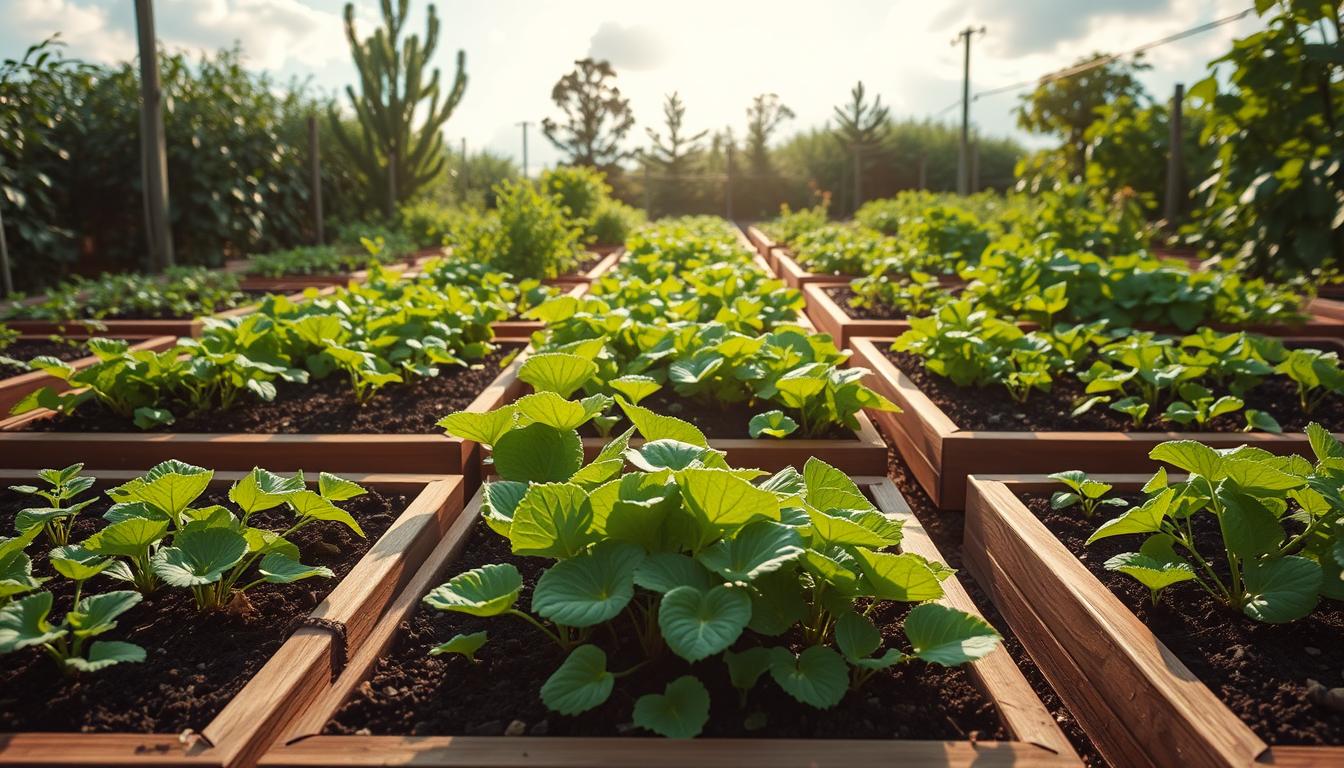Gardening enthusiasts, especially those with limited space, have found a game-changing method to grow their favorite plants. Developed by Mel Bartholomew in the 1970s, this innovative approach focuses on efficiency and organization. By using raised beds and a grid system, you can grow more in less space.
This method is perfect for urban dwellers, beginners, and even those with limited mobility. With a 4×4-foot bed, you can grow up to 16 times more produce than traditional row gardening. It’s not just about saving space; it’s about making gardening easier and more productive.
From reduced weeding to water conservation, the benefits are numerous. This guide will walk you through every step, from building your bed to harvesting your crops. Whether you’re new to gardening or looking to optimize your space, this method is worth exploring.
Key Takeaways
- Developed by Mel Bartholomew in the 1970s for efficient gardening.
- Uses 4×4-foot raised beds with a grid system for organized planting.
- Grows up to 16 times more produce than traditional methods.
- Ideal for urban gardeners, beginners, and those with limited mobility.
- Reduces weeding and conserves water effectively.
- Beginner-friendly design makes it easy to start and maintain.
- Provides actionable steps from bed construction to harvest.
What Is Square Foot Gardening?
For those looking to maximize their growing area, square-foot gardening offers a structured and efficient solution. This method divides your planting space into a grid, allowing you to grow more in less area. It’s ideal for urban settings, beginners, and anyone who wants to simplify their gardening process.
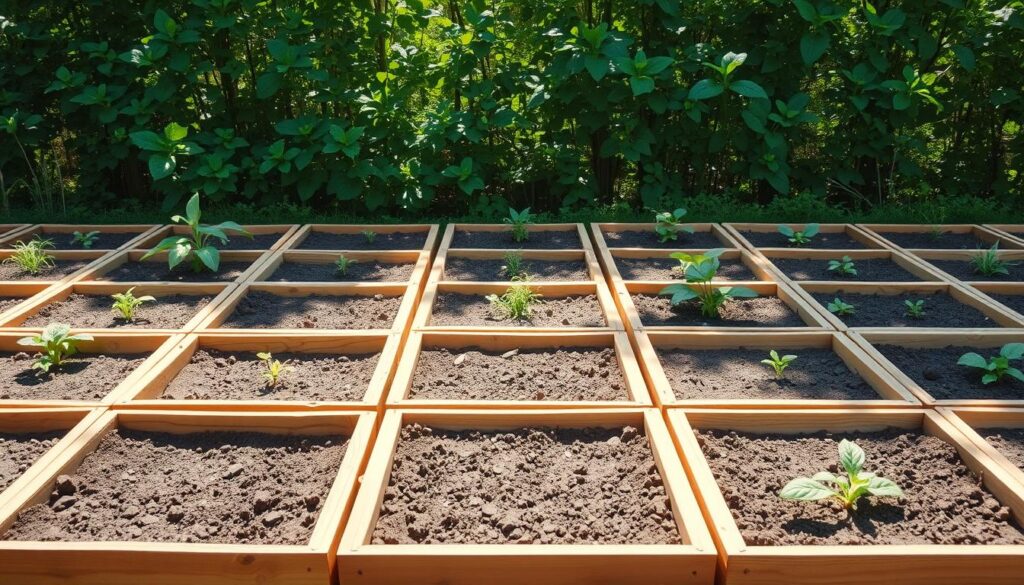
The Basics of Square-Foot Gardening
The core principle is simple: divide your planting area into 1×1-foot squares. Each square holds a specific number of plants, depending on their size. For example, you can grow one tomato plant or 16 carrots in a single square. This system ensures every inch of your space is used effectively.
Originally, Mel Bartholomew recommended a soil mix called Mel’s Mix, made of peat moss, vermiculite, and compost. Today, many gardeners use sustainable alternatives like coconut coir or 100% recycled compost. The soil is key to success, providing nutrients and proper drainage for healthy growth.
Benefits of Square-Foot Gardening
This method offers numerous advantages. It uses 80% less water and reduces weeding by 90%, making it eco-friendly and low-maintenance. The raised beds are accessible for people with limited mobility, and the organized grid makes it easy to manage.
You can grow over 60 varieties of plants, from vegetables to herbs. Compared to traditional row gardening, this system yields more produce per square foot. It’s also adaptable, working well in both small and large spaces.
Common Misconceptions
Some believe this method is only for small areas, but it’s equally effective in larger settings. Others think it limits plant choices, but it actually supports a wide range of crops. While the initial setup may seem costly, the long-term savings on water and maintenance make it worthwhile.
Square-foot gardening has proven successful in diverse environments, from urban balconies to rural front yards. It’s a flexible, efficient way to grow your own food, no matter where you live.
Planning Your Square Foot Garden
Starting a garden doesn’t have to be overwhelming—planning is the key to success. A well-organized garden layout ensures you make the most of your space, whether you’re growing vegetables, herbs, or other crops. Let’s break down the essential steps to get started.
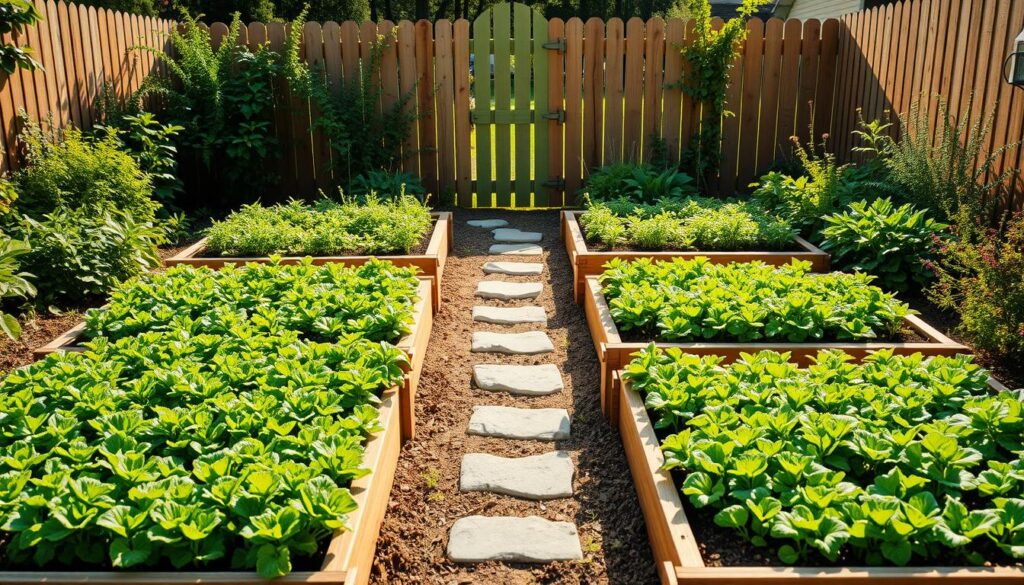
Choosing the Right Location
Sunlight is crucial for healthy plants. Aim for an area that gets 6-8 hours of direct sunlight daily. Use tools like the Sun Surveyor app to map sun exposure throughout the day. This helps you identify the best spot for your garden layout.
Accessibility is another factor. Ensure your chosen area is easy to reach for watering, weeding, and harvesting. A flat surface is ideal to prevent water runoff and uneven growth.
Determining the Size of Your Garden
The size of your garden depends on your household’s needs. A 4×4-foot bed is a popular choice, allowing a 2-foot reach from all sides. For a family of four, 1-2 beds per person are recommended. This ensures you have enough space for a variety of crops.
If space is limited, consider vertical gardening for plants like cucumbers and beans. This maximizes your growing area without taking up extra feet on the ground.
Selecting the Best Plants for Your Space
Not all plants require the same amount of space. For example, you can grow 16 radishes per square foot, but only one broccoli plant. Here’s a quick guide to help you decide:
| Plant | Spacing (per square) |
|---|---|
| Radishes | 16 |
| Carrots | 16 |
| Tomatoes | 1 |
| Basil | 4 |
Companion planting can also boost growth. For example, onions pair well with carrots, and basil enhances tomatoes. Avoid problematic combinations like potatoes near tomatoes, as they can attract similar pests.
To ensure a continuous harvest, create a sequential planting schedule. This allows you to rotate crops and prevent soil depletion. A case study from a Denver chef showed 19 varieties thriving in just 20 square feet—proof that careful planning pays off.
“The right garden layout can transform even the smallest space into a productive oasis.”
Building Your Square Foot Garden
Creating a productive and organized growing space starts with the right materials and setup. Whether you’re a beginner or an experienced gardener, this step-by-step guide will help you build a garden that maximizes efficiency and yields.
Materials Needed for Raised Beds
Choosing the right materials is crucial for durability and safety. ACQ-treated lumber is a popular choice, but cedar and composite decking are excellent alternatives. Cinder blocks are a budget-friendly option, costing around $25 compared to $120 for cedar.
For those concerned about sustainability, recycled materials like composite decking are a great choice. Avoid pressure-treated wood from pre-2004, as it may contain harmful chemicals. Always prioritize safety when selecting materials for your raised beds.
Constructing the Garden Bed
Building your garden bed is straightforward with the right tools. Start by cutting your lumber to size, ensuring each piece is uniform. Use power tools safely, wearing protective gear like gloves and goggles.
Assemble the frame by securing the corners with screws or brackets. For added convenience, consider adding casters to make your garden mobile. This is especially useful for patios or small spaces. Once the frame is ready, layer the bottom with cardboard to suppress weeds.
Fill the bed with a nutrient-rich soil mix. A lasagna-style layering method, alternating cardboard and compost, works well. This creates a fertile environment for your plants to thrive.
Creating the Grid System
The grid system is the heart of this gardening method. It divides your bed into 1×1-foot sections, ensuring organized planting. You can use wooden lath, PVC pipes, or nylon string to create the grid.
For a cost-effective option, bamboo stakes are ideal. They’re durable, easy to install, and cost around $5. Simply measure and mark each square, then secure the stakes or string at the intersections.
If you prefer a reusable option, check out the UF/IFAS Orange County Extension’s tutorial on creating a durable grid. This ensures your garden remains organized season after season.
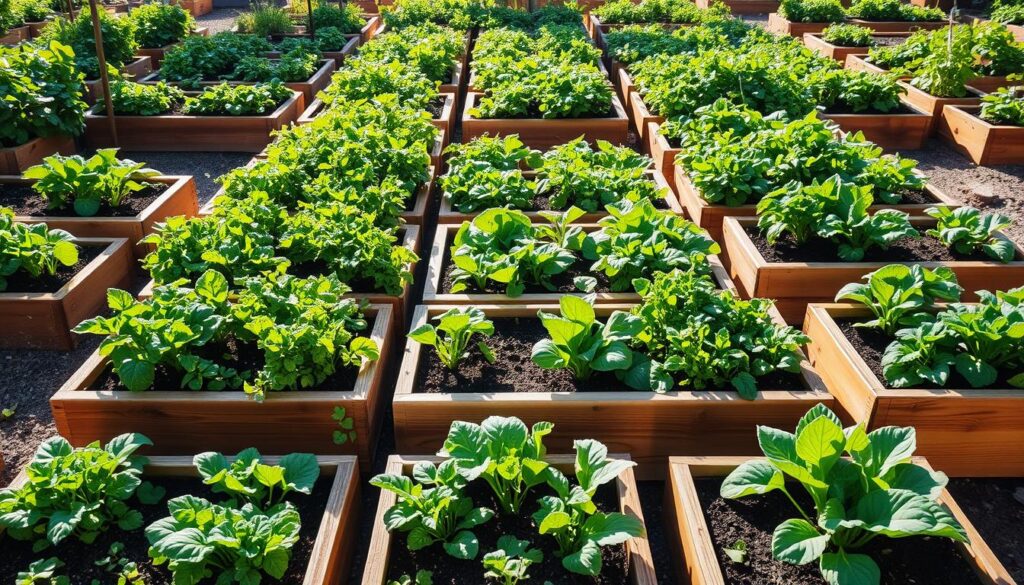
| Material | Cost | Durability |
|---|---|---|
| Cedar | $120 | High |
| Cinder Blocks | $25 | Medium |
| Composite Decking | $90 | High |
With the right materials and a well-planned layout, your garden will be ready for planting. For more tips on getting started, check out this guide on gardening for beginners.
Planting in Your Square Foot Garden
Planting in an organized system ensures every inch of your space is used effectively. By understanding plant spacing, companion planting, and seasonal timing, you can maximize your crop yield and create a thriving environment for your plants.
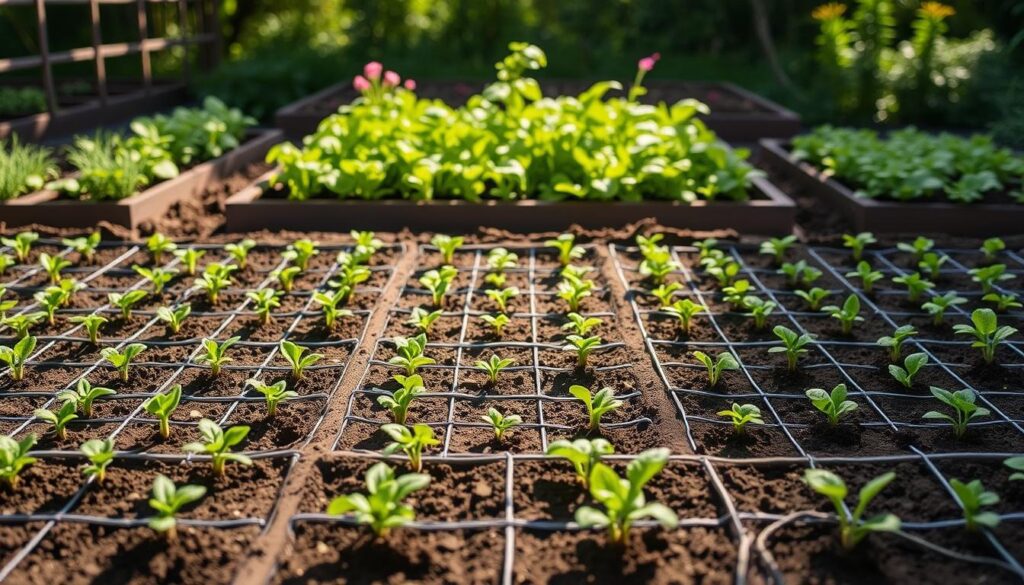
Understanding Plant Spacing
Proper spacing is crucial for healthy growth. For example, a pepper plant needs one square foot to thrive, while radishes can grow 16 per square foot. The Garden Grid™ system combines irrigation and spacing guides to simplify this process.
Here’s a quick reference for common plants:
| Plant | Spacing (per square) |
|---|---|
| Pepper | 1 |
| Radish | 16 |
| Tomato | 1 |
| Basil | 4 |
Companion Planting Tips
Companion planting enhances growth and deters pests. The 3 sisters method—corn, beans, and squash—is a classic example. Corn provides support for beans, beans add nitrogen to the soil, and squash shades the ground to retain moisture.
Other beneficial pairings include:
- Onions with carrots to repel pests.
- Marigolds with tomatoes to deter nematodes.
- Nasturtiums with cucumbers to repel aphids.
Seasonal Planting Guide
Timing is key to a successful harvest. Use seasonal charts to plan your planting schedule. For example, plant radishes between slow-growing cabbage for efficient use of space.
Here’s a basic timeline for USDA zones 3-9:
- Spring: Lettuce, peas, and spinach.
- Summer: Beans, tomatoes, and peppers.
- Fall: Kale, carrots, and beets.
“Succession planting ensures a continuous harvest throughout the year.”
For frost protection, consider using hoop houses or row covers. Tools like the Almanac’s 7-day garden planner trial can help you stay on track.
Maintaining Your Square Foot Garden
Keeping your garden thriving requires consistent care and attention. Regular maintenance ensures your plants stay healthy and productive. From watering to pest control, each step plays a vital role in your garden’s success.
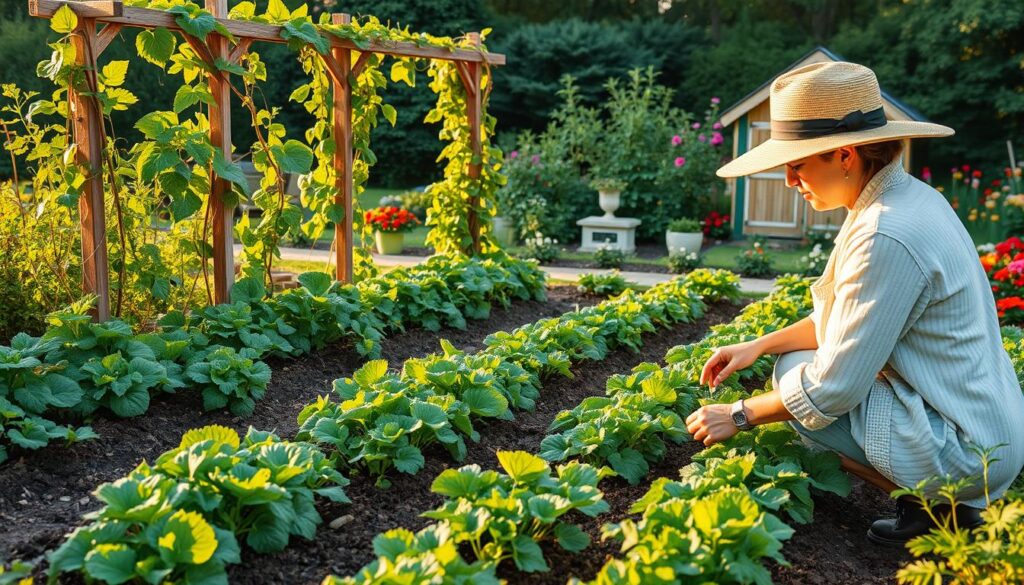
Watering and Fertilizing Tips
Proper hydration is key to healthy plants. Drip irrigation is an efficient option, delivering water directly to the roots and reducing waste. Hand-watering works too, but it requires more time and effort.
For a DIY solution, try a self-watering system using 5-gallon buckets. This method keeps the soil moist without overwatering. Adding organic fertilizer, like compost made from kitchen scraps, enriches the soil and boosts plant growth.
Managing Pests and Diseases
Pests can harm your plants, but organic solutions are effective. Neem oil is a natural pesticide that works well against aphids and other common pests. Apply it weekly for best results.
For a quick fix, mix soap and water to create a spray. This solution suffocates pests without harming your plants. Regularly inspect your garden to catch issues early and prevent infestations.
Harvesting and Rotating Crops
Harvesting at the right time encourages regrowth and maximizes yield. Use clean tools to avoid damaging your plants. For example, snip herbs just above a leaf node to promote new growth.
Crop rotation is essential for maintaining soil health. Avoid planting the same family of crops in the same bed each season. For example, rotate nightshades (tomatoes, peppers) with brassicas (cabbage, kale) and legumes (beans, peas).
“Healthy soil is the foundation of a thriving garden.”
| Task | Frequency |
|---|---|
| Watering | Daily (as needed) |
| Fertilizing | Every 2-3 weeks |
| Pest Inspection | Weekly |
| Harvesting | As crops mature |
By following these tips, you’ll create a low-maintenance, high-yield garden. With a little effort, your gardening space will flourish season after season.
Conclusion
Square foot gardening is a simple yet powerful way to grow fresh produce, even in small spaces. With an 89% success rate for beginners, it’s a method that delivers results quickly and efficiently. Start small with a 3×3′ starter bed to get the hang of it, then expand as your confidence grows. In year two, consider adding fruit trees or vertical structures to maximize your space.
This method isn’t just for individuals—it’s perfect for communities too. Many schools have adopted square foot gardening to teach kids about sustainability and healthy eating. It’s a great way to bring people together while growing fresh, organic food.
Here’s a pro tip: Photograph your garden weekly to track progress and identify areas for improvement. For those ready to dive in, we offer free printable planning templates to help you get started. As Mel Bartholomew said, “Grow more in less space with less work.” It’s time to transform your space into a thriving oasis.

